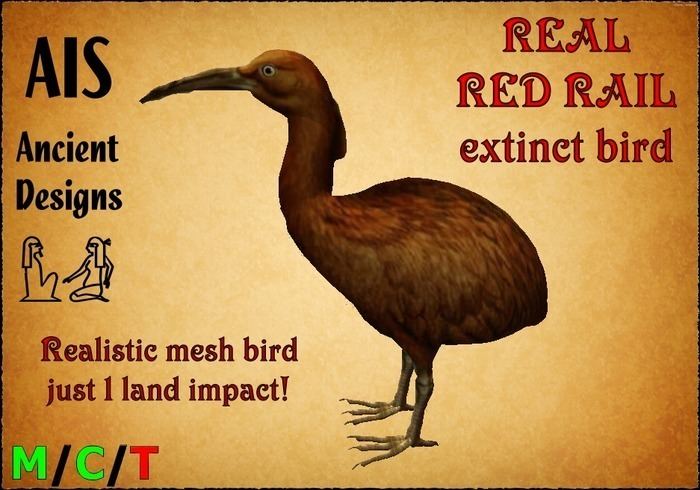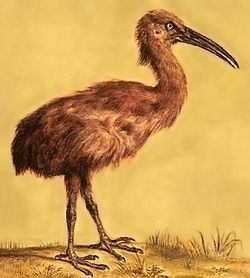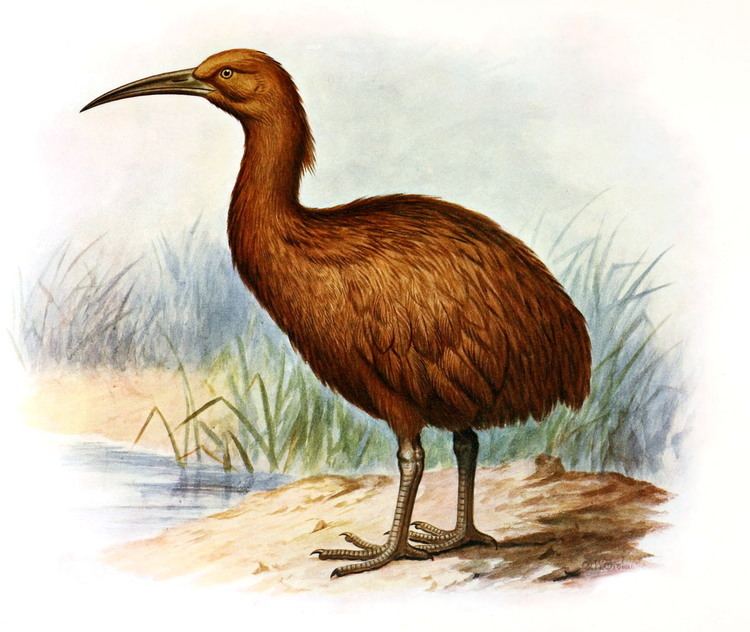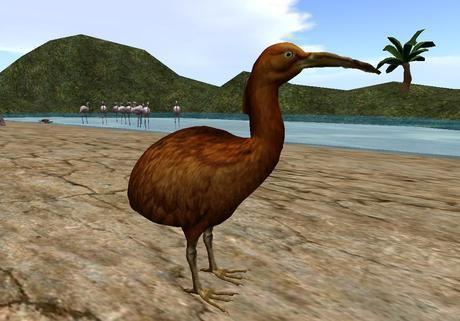Class Aves Family Rallidae Rank Species | Phylum Chordata Scientific name Aphanapteryx bonasia | |
 | ||
Genus AphanapteryxFrauenfeld, 1868 Similar Bird, Rodrigues rail, Broad‑billed parrot, Mascarene coot, Tahiti rail | ||
Red rail meaning
The red rail (Aphanapteryx bonasia) is an extinct species of flightless rail. It was endemic to the Mascarene island of Mauritius, east of Madagascar in the Indian Ocean. It had a close relative on Rodrigues island, the likewise extinct Rodrigues rail (Erythromachus leguati), with which it is sometimes considered congeneric. Its relationship with other rails is unclear. Rails often evolve flightlessness when adapting to isolated islands, free of mammalian predators.
Contents
- Red rail meaning
- Taxonomy
- Evolution
- Description
- Contemporary descriptions
- Contemporary depictions
- Behaviour and ecology
- Relationship with humans
- Extinction
- References

The red rail was a little larger than a chicken and had reddish, hairlike plumage, with dark legs and a long, curved beak. The wings were small, and its legs were slender for a bird of its size. It was similar to the Rodrigues rail, but was larger, and had proportionally shorter wings. It has been compared to a kiwi or a limpkin in appearance and behaviour. It is believed to have fed on invertebrates, and snail shells have been found with damage matching an attack by its beak. Human hunters took advantage of an attraction red rails had to red objects by using coloured cloth to lure the birds so that they could be beaten with sticks.

Until subfossil remains were discovered in the 1860s, scientists only knew the red rail from 17th century descriptions and illustrations. These were thought to represent several different species, which resulted in a large number of invalid junior synonyms. It has been suggested that all late 17th-century accounts of the dodo actually referred to the red rail, after the former had become extinct. The last mention of a red rail sighting is from 1693, and it is thought to have gone extinct around 1700, due to predation by humans and introduced species.

Taxonomy

The red rail was long known only from a few contemporary descriptions referring to red "hens" and names otherwise used for grouse or partridges in Europe, as well as the sketches of the travellers Pieter van den Broecke and Sir Thomas Herbert from 1617 and 1634. These were thought to depict separate species of birds by some authors, but were regarded as one by Hugh Edwin Strickland in 1848. Hermann Schlegel thought Broecke's sketch depicted a smaller dodo species from Mauritius, and that the Herbert sketch showed a dodo from Rodrigues, and named them Didus broecki and Didus herberti in 1854. Jacob Hoefnagel's 1610 painting, the 1601 sketch from the Gelderland ship's journal, and Peter Mundy's 1638 description and sketch later surfaced, but there was still uncertainty about the identity of the birds depicted.

In the 1860s, subfossil foot bones and a lower jaw were found along with remains of other Mauritian animals in the Mare aux Songes swamp, and were identified as belonging to a rail by Alphonse Milne-Edwards in 1866. He also determined they belonged to the birds in the 17th century descriptions and illustrations. In 1869, Milne-Edwards combined the genus name of Aphanapteryx imperialis, which had been coined the previous year by Georg Ritter von Frauenfeld for the Hoefnagel painting, with the older specific name broecki. Due to nomenclatural priority, the genus name was later combined with the oldest species name bonasia, which was coined by Edmond de Sélys Longchamps in 1848. Sélys Longchamps had originally named the genus Apterornis, wherein he also included the Réunion solitaire and the Réunion swamphen, but the name was preoccupied by Aptornis, a bird described by Richard Owen in 1844. Aphanapteryx means "invisible-wing", but the meaning of bonasia is unclear. Some early accounts refer to red rails by the vernacular names for the hazel grouse, Tetrastes bonasia, so the name evidently originates there. The name itself perhaps refers to bonasus, meaning "bull" in Latin, or bonum and assum, meaning "good roast". It has also been suggested to be a Latin form of the French word bonasse, meaning simple-minded or good-natured.
More fossils were later found by Theodore Sauzier, who had been commissioned to explore the "historical souvenirs" of Mauritius in 1889. Around the end of the 19th century, a complete specimen was found by the barber Louis Etienne Thirioux, who also found important dodo remains.
Evolution
Apart from being a close relative of the Rodrigues rail, the relationships of the red rail are uncertain. The two are commonly kept as separate genera, Aphanapteryx and Erythromachus, but have also been united as species of Aphanapteryx at times. They were first generically synonymised by Edward Newton and Albert Günther in 1879, due to skeletal similarities. Based on geographic location and the morphology of the nasal bones, it has been suggested that they were related to the genera Gallirallus, Dryolimnas, Atlantisia, and Rallus. Rails have reached many oceanic archipelagos, which has frequently led to speciation and evolution of flightlessness. The fact that the red rail lost much of its feather structure indicates it was isolated for a long time. These rails may be of Asian origin, like many other Mascarene birds.
Description
From the subfossil bones, illustrations and descriptions, it is known that the red rail was a flightless bird, somewhat larger than a chicken. Subfossil specimens range in size, which may indicate sexual dimorphism, as is common among rails. Its exact length is unknown, but the pelvis was 60 mm (2.4 in) in length, the femur was 69–71 mm (2.7–2.8 in), the tibia was 98–115 mm (3.9–4.5 in), the tarsometatarsus was 79 mm (3.1 in), and the humerus was 60–66 mm (2.4–2.6 in). Its plumage was reddish brown all over, and the feathers were fluffy and hairlike; the tail was not visible in the living bird and the short wings likewise also nearly disappeared in the plumage. It had a long, slightly curved, brown bill, and some illustrations suggest it had a nape crest. It perhaps resembled a lightly built kiwi, and it has also been likened to a limpkin, both in appearance and behaviour.
The sternum and humerus were small, indicating that it had lost the power of flight. Its legs were long and slender for such a large bird, but the pelvis was compact and stout. It differed from the Rodrigues rail, its closest relative, in having a proportionately shorter humerus, a narrower and longer skull, and having shorter and higher nostrils. They differed considerably in plumage, based on early descriptions. The red rail was also larger, with somewhat smaller wings, but their leg proportions were similar. The pelvis and sacrum was also similar.
Contemporary descriptions
The English traveller Peter Mundy visited Mauritius in 1638 and described the red rail as follows:
The yellowish colouration instead of the red mentioned by other accounts has been used as argument for this referring to a distinct species, Kuina mundyi, but it has also been suggested it was due to the observed bird being a juvenile. Another English traveller, John Marshall, described the bird as follows in 1668:
Contemporary depictions
Much information about the bird's appearance comes from a painting attributed to Jacob Hoefnagel, based on a bird in the menagerie of Emperor Rudolph II around 1610. It is the only coloured depiction of the species, showing the plumage as reddish brown, but it is unknown whether it was based on a stuffed or living specimen. The bird had most likely been brought alive to Europe, as it is unlikely that taxidermists were on board the visiting ships, and spirits were not yet used to preserve biological specimens. Most tropical specimens were preserved as dried heads and feet. It had probably lived in the emperor's zoo for a while together with the other animals painted for the same series. The painting was discovered in the emperor's collection and published in 1868 by Georg von Frauenfeld, along with a painting of a dodo from the same collection and artist. This specimen is thought to have been the only red rail that ever reached Europe.
The travel journal of the Dutch East India Company ship Gelderland (1601–1603), rediscovered in the 1860s, contains good sketches of several now-extinct Mauritian birds attributed to the artist Joris Laerle, including an unlabelled red rail. The bird appears to have been stunned or killed, and the sketch is the earliest record of the species, but was only rediscovered in the 1860s. The image was sketched with pencil and finished in ink, but details such as a deeper beak and the shoulder of the wing are only seen in the underlying sketch. In addition, there are three rather crude black-and-white sketches, but differences in them were enough for some authors to suggest that each image depicted a distinct species, leading to the creation of several scientific names which are now synonymous with Aphanapteryx bonasia.
There are also depictions of what appears to be a red rail in three of Roelant Savery's paintings. In his famous Edwards' Dodo painting from 1626, a rail-like bird is seen swallowing a frog behind the dodo, but this identification has been doubted, and it may instead show a bittern. A bird resembling a red rail is also figured in Jacopo Bassano's painting Arca di Noè ("Noah's Ark") from c. 1570. It has been pointed out that it is doubtful that a Mauritian bird could have reached Italy this early, but the attribution may be inaccurate, as Bassano had four artist sons who used the same name. A similar bird is also seen in Jan Brueghel the Elder's Noah's Ark painting.
Behaviour and ecology
Contemporary accounts are repetitive and do not shed much light on the bird's life history. The shape of the beak indicates it could have captured reptiles and invertebrates. There were many endemic land snails on Mauritius, including the extinct Tropidophora carinata, and subfossil shells have been found with damage matching attacks from the beak of the red rail. No contemporary accounts were known to mention the red rail's diet, until the 1660s report of Johannes Pretorius about his stay on Mauritius was published in 2015, where he mentioned that the bird "scratches in the earth with its sharp claws like a fowl to find food such as worms under the fallen leaves."
An anonymous Dutchman gave some description of behavioural traits in 1631:
While it was swift and could escape when chased, it was easily lured by waving a red cloth, which they approached to attack; a similar behaviour was noted in its relative, the Rodrigues rail. The birds could then be picked up, and their cries when held would draw more individuals to the scene, as the birds, which had evolved in the absence of mammalian predators, were curious and not afraid of humans.
The English traveller Sir Thomas Herbert described its behaviour towards red cloth in 1634:
Many other endemic species of Mauritius became extinct after the arrival of man heavily damaged the ecosystem, making it hard to reconstruct. Before humans arrived, Mauritius was entirely covered in forests, but very little remains today due to deforestation. The surviving endemic fauna is still seriously threatened. The red rail lived alongside other recently extinct Mauritian birds such as the dodo, the broad-billed parrot, the Mascarene grey parakeet, the Mauritius blue pigeon, the Mauritius owl, the Mascarene coot, the Mauritian shelduck, the Mauritian duck, and the Mauritius night heron. Extinct Mauritian reptiles include the saddle-backed Mauritius giant tortoise, the domed Mauritius giant tortoise, the Mauritian giant skink, and the Round Island burrowing boa. The small Mauritian flying fox and the snail Tropidophora carinata lived on Mauritius and Réunion, but became extinct in both islands. Some plants, such as Casearia tinifolia and the palm orchid, have also become extinct.
Relationship with humans
Though Mauritius had previously been visited by Arab vessels in the Middle Ages and Portuguese ships between 1507 and 1513, they did not settle on the island. The Dutch Empire acquired the island in 1598, renaming it after Maurice of Nassau, and it was used from then on for the provisioning of trade vessels of the Dutch East India Company. To the sailors who visited Mauritius from 1598 and onwards, the fauna was mainly interesting from a culinary standpoint. The dodo was sometimes considered rather unpalatable, but the red rail was a very popular gamebird for the Dutch and French settlers. The reports dwell upon the varying ease with which the bird could be caught according to the hunting method and the fact that when roasted it was considered similar to pork.
Johann Christian Hoffmann, who was on Mauritius in the early 1670s, described a red rail hunt as follows:
Hoffman's account refers to the red rail by the German version of the Dutch name originally applied to the dodo, "dod-aers", and John Marshall used "red hen" interchangeably with "dodo" in 1668. The ecologist Anthony Cheke has suggested that the name "dodo" was transferred to the red rail after the former had gone extinct, so that all post 1662 references to "dodos" refer to the rail instead. A 1681 account of a "dodo", previously thought to have been the last, mentioned that the meat was "hard", similar to the description of red hen meat. Errol Fuller has also cast the 1662 "dodo" sighting in doubt, as the reaction to distress cries of the birds mentioned matches what was described for the red rail. Milne-Edwards suggested that early travellers may have confused young dodos with red rails.
230 years before Charles Darwin's theory of evolution, the appearance of the red rail and the dodo led Peter Mundy to speculate:
Extinction
In addition to hunting pressure by humans, the fact that the red rail nested on the ground made it vulnerable to pigs and other introduced animals, which ate their eggs and young, probably contributing to its extinction. Feral cats, which are effective predators of ground-inhabiting birds, increased in numbers around the 1680s. When François Leguat, who had become familiar with the Rodrigues rail in the preceding years, arrived on Mauritius in 1693, he remarked that the red rail had already become rare. He was the last source to mention the bird, so it is assumed that it became extinct around 1700.
